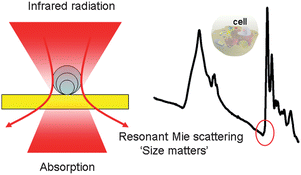Infrared spectroscopic cytology is potentially a powerful clinical tool. However, in order for it to be successful, practitioners must be able to extract reliably a pure absorption spectrum from a measured spectrum that often contains many confounding factors. The most intractable problem to date is the, so called, dispersion artefact which most prominently manifests itself as a sharp decrease in absorbance on the high wavenumber side of the amide I band in the measured spectrum, exhibiting a derivative-like line shape. In this paper we use synchrotron radiation FTIR micro-spectroscopy to record spectra of mono-dispersed poly(methyl methacrylate) (PMMA) spheres of systematically varying size and demonstrate that the spectral distortions in the data can be understood in terms of resonant Mie scattering. A full understanding of this effect will enable us to develop strategies for deconvolving the scattering contribution and recovering the pure absorption spectrum, thus removing one of the last technological barriers to the development of clinical spectroscopic cytology.

You have access to this article
 Please wait while we load your content...
Something went wrong. Try again?
Please wait while we load your content...
Something went wrong. Try again?


 Please wait while we load your content...
Please wait while we load your content...